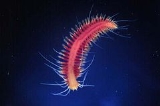
Hesionidae
Encyclopedia
Hesionidae are a family
of phyllodocid
"bristle worms" (class
Polychaeta). They are (like almost all polychaetes) marine organisms. Most are found on the continental shelf
; Hesiocaeca methanicola
is found on methane ice, where it feeds on bacteria
l biofilm
s.
A characteristic apomorphy of the Hesionidae are the cirrophores of the anterior segments, which are well-developed cup-like sheaths; the cirri of the subsequent segments insert into the parapodia directly, or with just a vestigial cirrophore.
, the Hesionidae belong to the order
Aciculata
, one of the three main clade
s of polychaetes. They appear to be part of the basal radiation of the main lineage of phyllodocids, alongside such families as the ragworms (Nereididae), the Pilargidae and Sphaerodoridae which are closely related to each other, the very ancient Syllidae, and perhaps the more advanced catworms (Nephtyidae).
Numerous genera are still treated as Hesionidae incertae sedis
, not reliably assignable to either of the three generally recognized hesionid subfamilies:
Family (biology)
In biological classification, family is* a taxonomic rank. Other well-known ranks are life, domain, kingdom, phylum, class, order, genus, and species, with family fitting between order and genus. As for the other well-known ranks, there is the option of an immediately lower rank, indicated by the...
of phyllodocid
Phyllodocida
Phyllodocida is an order of polychaete worms in the subclass Aciculata. These worms are mostly marine though some are found in brackish water. Most are active benthic creatures, moving over the surface or burrowing in sediments, or living in cracks and crevices in bedrock. A few construct tubes in...
"bristle worms" (class
Class (biology)
In biological classification, class is* a taxonomic rank. Other well-known ranks are life, domain, kingdom, phylum, order, family, genus, and species, with class fitting between phylum and order...
Polychaeta). They are (like almost all polychaetes) marine organisms. Most are found on the continental shelf
Continental shelf
The continental shelf is the extended perimeter of each continent and associated coastal plain. Much of the shelf was exposed during glacial periods, but is now submerged under relatively shallow seas and gulfs, and was similarly submerged during other interglacial periods. The continental margin,...
; Hesiocaeca methanicola
Hesiocaeca methanicola
Methane clathrate deposits in the ocean floor have been found to be inhabited by polychaete worms of the species Hesiocaeca methanicola. The worms colonize the methane ice and appear to survive by gleaning bacteria which in turn metabolize the clathrate....
is found on methane ice, where it feeds on bacteria
Bacteria
Bacteria are a large domain of prokaryotic microorganisms. Typically a few micrometres in length, bacteria have a wide range of shapes, ranging from spheres to rods and spirals...
l biofilm
Biofilm
A biofilm is an aggregate of microorganisms in which cells adhere to each other on a surface. These adherent cells are frequently embedded within a self-produced matrix of extracellular polymeric substance...
s.
A characteristic apomorphy of the Hesionidae are the cirrophores of the anterior segments, which are well-developed cup-like sheaths; the cirri of the subsequent segments insert into the parapodia directly, or with just a vestigial cirrophore.
Systematics
As phyllodocidsPhyllodocida
Phyllodocida is an order of polychaete worms in the subclass Aciculata. These worms are mostly marine though some are found in brackish water. Most are active benthic creatures, moving over the surface or burrowing in sediments, or living in cracks and crevices in bedrock. A few construct tubes in...
, the Hesionidae belong to the order
Order (biology)
In scientific classification used in biology, the order is# a taxonomic rank used in the classification of organisms. Other well-known ranks are life, domain, kingdom, phylum, class, family, genus, and species, with order fitting in between class and family...
Aciculata
Aciculata
Aciculata is an order of polychaete worms. These worms are found worldwide in marine environments and brackish water.-Families:Suborder Eunicida*Amphinomidae Savigny in Lamarck, 1818 *Diurodrilidae Kristensen and Niilonen, 1982...
, one of the three main clade
Clade
A clade is a group consisting of a species and all its descendants. In the terms of biological systematics, a clade is a single "branch" on the "tree of life". The idea that such a "natural group" of organisms should be grouped together and given a taxonomic name is central to biological...
s of polychaetes. They appear to be part of the basal radiation of the main lineage of phyllodocids, alongside such families as the ragworms (Nereididae), the Pilargidae and Sphaerodoridae which are closely related to each other, the very ancient Syllidae, and perhaps the more advanced catworms (Nephtyidae).
Numerous genera are still treated as Hesionidae incertae sedis
Incertae sedis
, is a term used to define a taxonomic group where its broader relationships are unknown or undefined. Uncertainty at specific taxonomic levels is attributed by , , and similar terms.-Examples:*The fossil plant Paradinandra suecica could not be assigned to any...
, not reliably assignable to either of the three generally recognized hesionid subfamilies:

